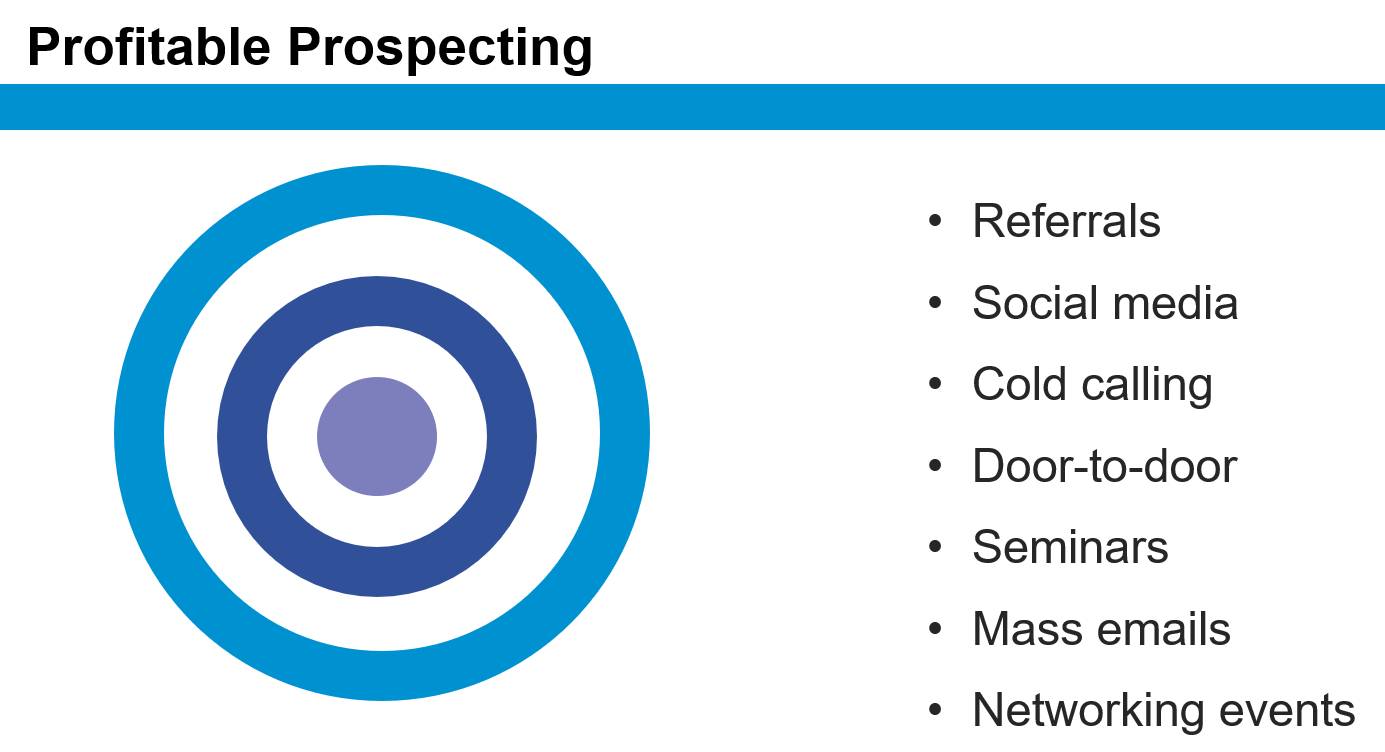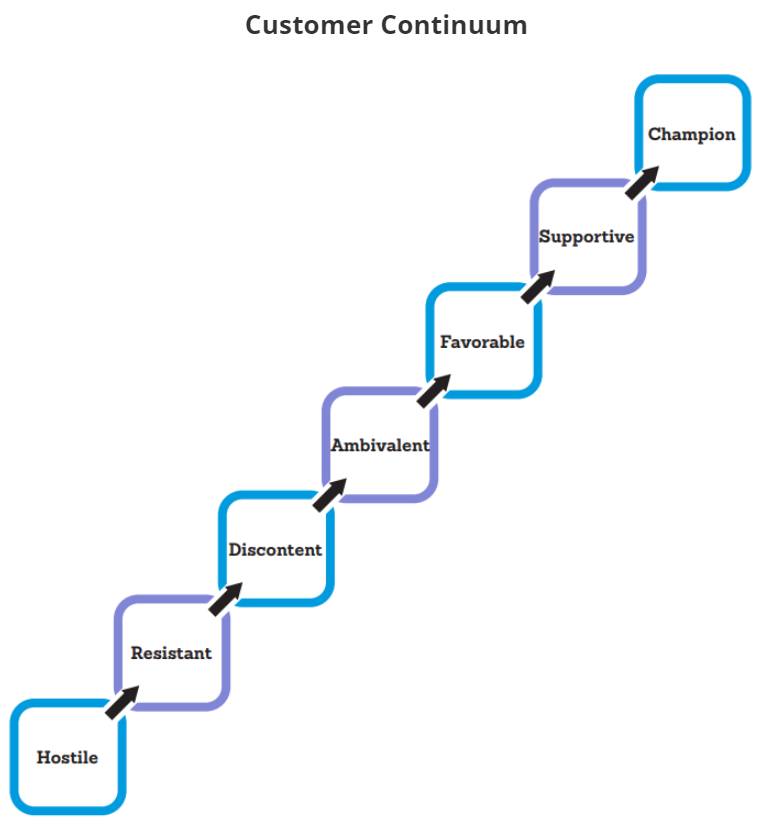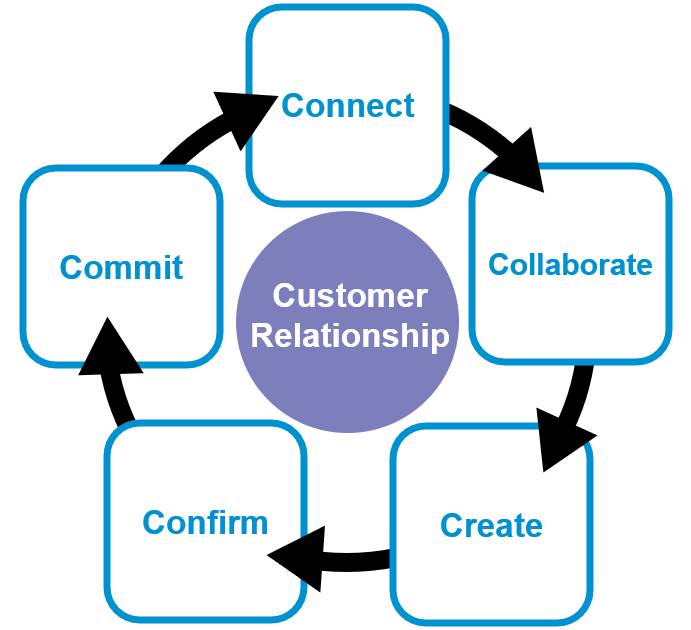Dig Deeper into Relationship Selling
Learning Objectives
After completing this unit, you’ll be able to:
- Explain the best way to get continued business.
- Apply relationship selling skills to gain champions for your solutions.
Find More Customers
Making the sale is only the beginning. In this unit, Dale Carnegie calls out different methods to develop continued business in order of effectiveness.
- Referrals
- Social media
- Cold calling
- Door-to-door
- Seminars
- Mass emails
- Networking events

Some approaches to prospecting are more successful than others depending on what is being sold. The center of the target (the bullseye) is always referrals. There is no better way to win a customer than to have someone the customer trusts recommend you. That said, everyone’s target looks different—and that’s OK!
Get the Referral
So, you’ve made a sale. But that shouldn’t be the end—ensuring they succeed is an important part of the relationship with the customer. On top of that, maintaining your relationship with them can help you gain more business. The highest return comes from getting more business from our existing accounts. The lowest return is from waiting for the phone to ring or for a client to walk into our office.
As you maintain your relationships with your existing customers—checking in to see how they’re succeeding, connecting them with the right people and resources, you are moving them along a continuum, with the end goal of converting them into Champions of your solution and company.
Champions are people who are loyal to you and your solution. They are likely to refer others to you. The best champions are articulate, dynamic, and well-respected within their organization.

Sales Process Review
As you gain repeated business and build your network of champions, it becomes apparent that the sales process is a cycle, instead of a set of steps with a beginning and end. Let’s review the Dale Carnegie Sales Process one more time with this in mind.

Connect
The first opportunity to begin building rapport and trust. Show that you care about the customer and their needs. This remains relevant even after you’ve made the sale. Stay connected with the customer by checking in with their implementation of the solution and afterward, to ensure they are succeeding. This goes a long way to developing the customer into a Champion and developing more sales stories.
Develop a client credibility statement.
Make a connection: Start the conversation.
Strike a nerve: Get their attention.
Tell a story: Build trust.
Connect with a sales story. Share your past successes in a quick and engaging way.
Incident: Describe the customer’s situation before implementing your solution.
Action: Explain how they solved the problem using your solution.
Benefit: Describe the value received by the customer.
Collaborate
Uncover true needs, wants, goals, and desires. Work with the customer to find a solution that will meet their needs and goals. You can also use the question model to dig deeper into their current successes with the solution you sold them.
Questioning Model
As Is Questions: Assess the customer's current situation.
Should Be Questions: Uncover the customer's vision regarding your solution.
Change Questions: Identify factors that prevent the customer from achieving the Should Be.
Payout Questions: Clarify how the customer and/or the organization benefits from the solution.
Implication Questions: Determine the significance of an occurrence.
Create
Present a solution that is customized to that specific person. Tailor evidence, examples, and how we position our solution. Perhaps there’s a need for additional training. Maybe the customer can use help from a subject matter expert as they continue their journey.
Summary Statement
Tell the customer about your ability to help them beyond the sale.
- Begin with a statement like, “Based on what you’ve told me…”
- Use quick, simple statements.
- Make a specific recommendation.
Confirm
Confirm with the customer that the solution will be effective. Now that you have a solid relationship with the customer, the solutions you create with them can be small or large. The point is that you’re continuously providing value.
Responding to Objections
| Tactic | Description |
|---|---|
|
Cushion |
A response that shows you listened to the concern and recognize its importance. It does not agree, disagree, or answer the objection. It acknowledges the emotion that was conveyed. |
|
Clarify |
Ask a nonthreatening question to clarify the objection. |
|
Cross-Check |
Confirm that the specific hesitation is the only factor preventing the commitment. |
|
Reply |
Deny, admit, or reverse the hesitation. Provide an explanation.
|
|
Trial Commitment |
Ask a question to determine if the objection has been resolved. |
Commit
Customers commit to the purchase and you commit to following up and continuing a relationship with them.
Commitment Methods
|
Method
|
Description
|
|---|---|
| Direct Question Method | Often the best way to gain commitment is to ask for it. |
| Alternate Choice Method | Ask the customer to select one of two options. |
| Minor Point Method | Call on the customer to make a minor decision that indicates the larger buying decision has been made. |
| Next-Step Method | Assume the sale has been made and look past the commitment to the last actions that need to be taken. |
| Opportunity Method |
Present the customer with a brief window of opportunity when options are available. |
| Weighing Method | If the customer still has second thoughts about making the purchase, show them how the return on investment outweighs the cost. |
Remember that all the focus and thinking in the world will not bring you more sales. You must act on what we’ve discussed to make a change. Dale Carnegie challenges you to act on what you’ve learned and to take your sales to the next level with relationship selling. You can find the Winning with Relationship Selling Course and other Dale Carnegie training courses at dalecarnegie.com.